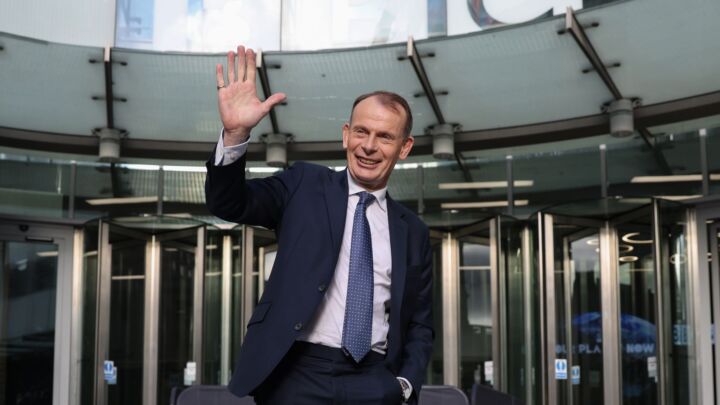Easy money is no solution for hard times
ESSAY: Monetary policies do nothing to address the West’s productive stupor.

Want unlimited, ad-free access? Become a spiked supporter.
Last week’s big economic story was the European Central Bank’s package of measures to ease monetary policy further in another bid to animate the ever-sluggish Eurozone region. This included the novel step of setting a negative interest rate for commercial banks depositing their money in the ECB’s coffers. This means the banks would have to pay for the privilege of putting money in the ECB – a rather desperate attempt to try to get them instead to lend their money to somebody, anybody, who might spend it on something.
Meanwhile, central banks in the US, Britain and Japan continue to rely on the ‘unconventional’ monetary policy of Quantitative Easing (QE) to try to do the same for their economies. QE is the mechanism whereby the banks have directly bought, and some continue to buy, financial assets as a way of pumping out hundreds of billions in extra money in the hope that this will get people using more of the stuff. Everywhere, it seems easy money policies are the official weapon of choice. There is even talk that China may launch its own version of QE in the face of its current economic headwinds.
This ubiquitous, and almost exclusive, dependence on monetary policy in state economic policymaking may not seem that gripping a development – perhaps relevant only if you are buying a house and wondering what type of mortgage to take out, or are doing a bit of household budgeting and are concerned that your savings seem to be falling in value because of negative interest rates. Is this occasion once again to reach for the old ‘dismal science’ quotation about economics?
No. Bear with us. For understanding this focus on the admittedly dry areas of central banking and monetary policy is of much greater importance than your personal finances.
Monetary policy is these days frequently described as ‘the only game in town’. That’s pretty true, but it is a ‘game’ that has innate limitations. Debates about interest-rate levels, or about different types of monetary policy – conventional or unconventional; inflation targeting, or price-level targeting, or nominal-output targeting – or about the related so-called ‘macroprudential’ financial policies that central banks also issue, are significant not for the technical pros and cons of each possible step, but for what all this says about the narrow arena in which the state focuses its overt economic operations.
All the attention focused on monetary and financial policy tells us three important things about the West’s current effort to address its slow drift of economic malaise: first, about its politics; secondly, about its economics; and, thirdly, about the potential for fixing today’s economic problems. The conclusion is that getting out of this contained slump is going to need something very different to another batch of easy money policies. It will require significant business restructuring and a commitment to a wholesale and radical economic renaissance. Easy money is not a step along this road; rather, it has helped to cover up the urgent need for real change.
Economic policy loses its democratic anchor
First, the political point: the financial focus of economic policymaking tells us just how technocratic and apolitical such policy has become.
Efforts to reinvigorate the economy and bring us the sort of jobs that can give us secure and rising living standards have been reduced to… adjusting how easy and at what price we and businesses can borrow money. There is no way of disguising it: these are technical levers only. Central banks don’t invest or produce or build anything – they simply set some technical parameters for the cost and availability of money that other real economic players in the economy are supposed to use. As Bank of England governor Mark Carney recently reiterated, central banks have limited powers over containing the housing price bubble that so many commentators are talking about. ‘We’re not going to build a single house at the Bank of England’, he said. ‘We can’t influence that.’ Fair point, and those who are expecting so much from central banking should reflect on it a little.
The near exclusive focus on monetary policy is also the area of policymaking that is the farthest away from the political arena and from democratic accountability. One of the big monetary policy themes of the past 30 years has been declaring central bank ‘independence’ from government, driven by the idea that you can’t trust those pesky politicians with something as important as the value of money and the control of inflation. Supposedly, irresolute politicians, rather than any deeper systemic problems, were to blame for the inflationary 1970s, a period that marked the passing of the postwar boom and during which the rate of inflation became the most talked-about economic indicator.
The idea of central bank ‘independence’ wasn’t a new thing even then. The German Bundesbank set up in 1957 created the model for modern central-bank independence. In that case, it was part of distancing the new (West) Germany from the crises of the Weimar Republic and the ensuing horrors of the Nazi period. Its institutional legacy of independence from democratic politics lives on today in the Maastricht Treaty (1992) that limits the formal room for manoeuvre of the European Central Bank (ECB). In particular, the Eurozone’s central bank is prohibited from helping to finance the implementation of Eurozone government spending policies by buying government debt. This explains the ECB’s reluctance so far to embrace QE, as all the other major central banks have done, forcing it to adopt other ways of pumping liquidity into Eurozone financial markets.
Earlier, during the first phase of the long slump that followed the end of the postwar boom, the apparent success of the US Federal Reserve under its tough chairman Paul Volcker in curbing inflation at the start of the 1980s inspired the idea of giving more authority to independent central banks. Since then, ‘independence’ from government has become the orthodox approach to central banking. So in 1997, one of the first acts of the New Labour government in Britain was chancellor Gordon Brown announcing ‘operational independence’ for the Bank of England.
Although central independence has always been a bit of a fiction – as historian Niall Ferguson noted, ‘In historical perspective, [central bank independence] has always been contingent on the requirements of the state’ (1) – it did express the tenor of the times in the depoliticisation of economic matters. The end of domestic social contestation in the West, with left-wing and even Labourist politics losing any remaining influence in the 1980s, led to the universal acceptance of market relations as the natural order.
The symbolic fall of the Berlin Wall a quarter of a century ago, and the subsequent implosion of the Soviet Bloc that brought the Cold War to an end, confirmed the apparent absence of any possible alternatives to the market. Hence this key aspect of ‘economics’ – whether the market was a positive or negative thing for society – was no longer an area of political difference and debate. It seemed everyone acknowledged the market as the right way to run an economy, from Washington to Beijing.
This universal acceptance of market relations seemed to endorse the ‘small state’ idea that governments had little legitimate role to play in promoting growth and economic development. It was claimed that the mixed-economy model had had its day. Recognition of the limitations of state economic intervention that followed the discrediting of Keynesian-type fiscal policies in the 1970s (they were blamed for all that inflation) dovetailed with increasing scepticism that economic growth was itself a good thing for society. This was the period of the rise of worries about the environmental impact of economic development and the pursuit instead of the ill-defined but inhibiting concept of ‘sustainable development’.
The political consequence of the new consensus around the market, combined with growing reservations about the benefits of growth, was that politicians became happy to take a backseat in economic policymaking. Heaven forbid that politicians themselves might want to take the lead role for economic change, never mind for economic renewal. They were keen to pass on authority to others, primarily to the central banks. The granting of monetary-policy responsibility to ‘independent’ central banks therefore expressed a generalised trend of distancing economic policy from the political arena. The result is that the most prominent area of economic policymaking is formally separated from the democratic accountability of elected government.
The rise of financialisation: an expression, not cause, of decay
The second thing that the focus on monetary matters highlights is how far the Western economies have become financialised – that is, have become driven by, and more dependent for their prosperity on, developments in the area of finance and financial activity. This transformation is one of the most important ways all the Western economies have coped with the post-1970 loss of momentum in their capacity and drive to produce goods and services. In short, the financial parts of the economy have expanded to compensate for the new weaknesses in the production parts.
This represents more than an active or large financial sector – this sector has risen in conditions in which the endogenous expansion of productive capital has lost its drive, exactly the circumstances we’ve been going through since the 1970s. Marked by step-change declines in profitability, in capital investment levels and in the growth of productivity and output, all the West’s economies have come to rely increasingly on financially driven mechanisms.
(Source: McKinsey Global Institute)
The monetary and financial focus of state economic intervention is a symptom of this shift. Economies where the financial sector has grown in importance, and, more importantly, where non-financial businesses are relatively more engaged in financial than in physical engineering, have drawn the state to concentrate its attentions in these areas, too, to support the financial institutions or to facilitate financial-type activities. The financialisation that arises from the hollowing out of the productive economy brings about the privileging of financial activities. This is where the central bank comes in to assume greater importance in the role of the state. The machinery of the state has not merely been a passive follower of this trend; it has also helped to support and foster financialisation and has tried to make the best of this structural shift.
What characterises financialisation? Financial activities become the recipient of the available cash that is no longer being drawn into productive investment and are able to support the economy for an indeterminate period. The distinction of a financialised economy is that while it is one that is less geared towards creating new values, it can help to compensate for this deficiency within the economy. The classic way it does this is through the extension of credit that allows businesses and people to carry on despite the relative inadequacy of newly produced values. Credit and the expansion of financial debt allow things to continue to be produced and consumed even when the value creation process is impaired.
The McKinsey chart below illustrates the generalised expansion of debt across the mature economies since the 1980s. It also shows that the acceleration was most pronounced in the weaker mature economies, including Britain. Britain’s total indebtedness rose from below 200 per cent of national output in the mid-1980s to about 500 per cent on the eve of the financial crisis, partly reflecting its role as an offshore banking hub, itself a particular expression of financialisation. In the US, too, the expansion of credit was pretty significant over this same period, rising from about 170 per cent to about 300 per cent. Relying upon credit is essentially a way to live and operate today off future potential values rather than values produced right now. Not even the heightened anxieties about excessive debt levels arising from the Western financial crisis could bring an end to the growth of debt. Total debt-to-GDP ratios have continued to grow in most Western countries since 2008, and in the US, the country regarded as the most successful in de-leveraging, the ratio has only fallen a smidgen, from 357 per cent in 2008 to 346 per cent last year (2).
(Source: Debt and Deleveraging pdf from McKinsey Global Institute)
The shift to a more financialised economy builds upon the relationship that finance has to the rest of the economy in more normal economic times, such as in nineteenth-century Britain, or during the post-Second World War boom across all the industrialised countries. In those eras, finance was essential to the day-to-day functioning of the economy, assisting with the financing of the production process and with the realisation of the values of goods and services produced on the market.
Finance is always, therefore, a distinctive part of the economy, but in those conditions of relatively steady economic growth, it is usually recognised as subordinate to the production part. No new value was being created within financial activities. Being a banker was never an especially disreputable occupation – more often portrayed as a bit boring – while in economic and cultural terms, being a producer was seen as more essential to modern-day life and prosperity. Whether it was discussions about the Cold War balance of power, or about the cultural arrival of ‘mass consumption’ and the new force of ‘marketing/advertising’, or simply about ensuring full employment, there was an instinctive recognition that production was what mattered. Production was key: certainly of goods (from raw materials to foodstuffs, cars, home appliances, ships and planes), but increasingly of services, too, not least the take-off in the twentieth century of the entertainment (TV/movies), hospitality (restaurants) and leisure (travel and hotels) industries.
The subordinate role for finance – economically and culturally – coexisted with a certain fictitious aspect to its existence, detached from where new values were being generated. Within this sphere itself, money seems to be a means to more money, and the role of production can get pushed into the background, even when it is the new values created in production that fund that ‘extra’ money in the form of the dividends and the other returns on financial investments.
This appearance expresses the real peculiarity of the money-form: money, except in its commodity form of gold (which hasn’t been of much relevance for a long time, not least since all the major currencies officially went off the gold standard in the interwar years), is not value itself but rather is a measure of value, the price of something. This mediated relationship to value contains within itself the scope for the price to be more flexible than the underlying value. Prices can vary while values may be fixed. Think of how the price of the same house can vary, even when you haven’t done anything physical to the house like adding an attic extension or putting decking in the backyard.
This detachment of prices from values, and therefore from production, also means that prices can attach themselves to things which have no underlying value in themselves. For example, company shares, or a buzz-phrase from the last financial crisis: CDOs – Collateralised Debt Obligations – where individual loans from banks are repackaged into a product that can be sold to other investors. The value of these financial assets is fictitious value. They are fictitious in that they can be bought and sold on financial markets; they are not assets that generate new value in themselves. Ownership of a company’s share certificate gives you part ownership of the company and the potential of some share in future profits, but the paper or electronic certificate can’t create additional value itself. You can’t even brandish your share certificate and march into the company’s premises and say ‘I own a bit of that machine, so give me a bit of what it’s produced today’; you actually own a bit of the corporate institution, not the physical assets of the company.
All these real features of the gap between value and price, and therefore between production and finance, provides the scope for financialisation to take off when new value production gets into chronic difficulties. The very detachment which in the ‘good’ times is a quaint if sometimes irritable feature of finance – when, for example, a producer, or homeowner, can’t get the price they want for their real commodity or asset – becomes a lifeline in the ‘bad’ times, such as we’ve had in the West since the 1970s. The financial indicators of the economy can continue to look better than things really are on the basis of contemporaneous value creation.
But this false sense of economic strength is also financialisation’s own undoing. The apparent stability created eventually leads to instability. Just as a non-financialised capitalist economy is prone to crisis, ultimately from falling profitability, so a financialised capitalism is also prone to crisis, but for different reasons. This is because the stability that is created in the here and now enables the continued extension of financialising activities until the gap with value reality gets too big. Intrinsic to financialisation is the potential for a mis-pricing of financial assets – known in financial circles as the ‘mis-pricing of risk’. These distortions are inevitable given the absence of a firm anchor in production, or in the value economy. Central-bank liquidity operations add accelerant to this process.
Eventually, a bubble bursts – the specific catalyst for this is usually unpredictable, and could be one of several catalysts – and then we have an implosion. Last time it was US house prices and sub-prime mortgages, but it could have been some other mis-priced, overvalued financial asset. The implosion usually ripples through the interconnected financial economy, and this brings the world back closer to the economic malaise from which it never really escaped.
Financialisation in the industrial economy, too
Financialisation is often expressed in the growth of the financial sector itself – this is especially pronounced in the case of Britain with the impact arising from its role as global financial hub. However, the more important and characteristic feature of financialisation is the adoption of financial activities by the non-financial sector, by the industrial economy in the widest sense.
The key feature of financialisation is the fusion of production with financial activity: the way that troubled non-financial companies turn to financial activity to shore up their reported profitability and cash generation. These financial activities range from debt issuance in order to fund business operations working at sub-par profitability, to financial engineering, where buying and selling companies takes precedence over productive investment to generate organic growth in the underlying businesses.
All this means there is a symbiotic relationship between the growth of the financial sector and the shift of industrial businesses to financial activities. Financial institutions expand their service functions to assist the non-financial ones in these ventures. For example, private-equity companies expand to assist managements who seek to change their ownership structure. Other financial companies have developed derivatives to help commercial companies not just insure themselves against adverse movements in the value of their products, but also in the movement of financial indicators upon which they increasingly depend: interest rates, exchange rates, or the prices of financial assets.
Most distinctively in this phase of financialisation, industrial firms begin to act as if they were financial ones. We have noted that the initial shift to more dependence on financial activities by non-financial business is driven by systemic weakness within production. But this doesn’t mean that businesses experience an absolute shortage of profits: the symptom of decay is not that profitability hits a certain level or rate, but that, increasingly, profits generated do not get used for expanding production. Instead, they flow to financial uses, such as buying back shares, increasing dividends, and the direct purchase of financial assets. These activities have given another fillip to stock-market prices, thereby accentuating the upside-down feature of financialisation that booming financial markets, which are claimed to anticipate the real economic future, actually coexist with real productive weakness.
A good indicator of growing financialisation is therefore in the balance sheets of companies outside the financial sector, and the way financial assets have become a bigger share of all assets. This illustrates the relative shift within industrial companies from productive operations to non-productive financial ones.
In the UK, the financial share of assets has risen steadily from about one-third at the start of the 1990s to over a half, peaking at 58 per cent before the financial crash devalued some of these holdings:
In the US, the trend was very similar. From the late 1940s through to the early 1980s, the ratio had remained pretty flat in the 21 to 27 per cent range and then began its steady ascent to reach a level just below a half – peaking in 2009 at 49 per cent. This illustrates that the step change in the relative importance of financial assets took place from the early 1980s, soon after the onset of the Long Slump.
A more specific exemplar of this trend is the growing share of reported profits for GE, America’s foremost industrial conglomerate, that derive from its financial arm, GE Capital. This grew from a small slither in the early 1980s to reach about one-third of GE’s total profits by the late 1990s, a significant contribution to support the rest of GE’s productive activities:
(Source: Julie Froud , Johal Sukhdev, Adam Leaver, and Karel Williams, Financialization and Strategy: Narrative and Numbers, Routledge, 2006)
Central banks assume their new authority
So, the tendency towards financialisation in times of productive decay is contained within the nature of the money-form and the structural relationship between finance and production. But for financialisation to flourish the way it has done has been more than a merely spontaneous act.
Financialisation does have a strong instinctive element when mature economies face greater barriers to producing things successfully. Available capital is attracted to this more flexible sphere, where money appears to beget more money (at least this side of the next financial crash), and without all that difficult business of having actually to produce and sell things. In this fundamental sense, financialisation is not the outcome of conscious intervention to promote the bankers at the expense of the producers. It is not the result of a state policy choice.
However, the state, by failing to rebuild the productive sectors, and by promoting the financial aspects of the modern economy, has fashioned the particular way financialisation has developed and functioned. It is therefore reasonable to characterise this evolving phenomenon of the past three decades as not just financialisation but as ‘state financialisation’.
Governments across the Western world have facilitated and encouraged the financialised economy. They have been happy for debts to grow and for the financial system to make the running. In Britain, the City of London, an historical product of Britain’s industrial and commercial leadership of the world in the nineteenth century, was given state backing in the twentieth century to help offset the decay of production. This has been especially pronounced since the 1960s, when the British state was happy for London to operate as the major off-shore trading centre for the emerging eurodollar market (US dollars that were held outside the US and therefore beyond the control of the US Federal Reserve), and especially since the 1980s, when Britain directly promoted financialisation with its Big Bang financial-sector reforms of 1986.
The ‘neoliberal’ narrative of financial ‘deregulation’ is therefore a rather one-sided take, and instances of deregulation are certainly no evidence of a smaller, more passive state. The regulation of the financial system changed since the 1970s to facilitate the scope for the financialisation to prop up the economy. These regulatory changes were not spontaneous but rather were the result of conscious state interventions. For example, previous restrictions on what individual financial institutions could and could not do were removed. Emblematic was the repeal in 1999 under President Clinton of the US Glass-Steagall Act from the 1930s, which had separated investment banks from commercial banks, complemented by decisions not to subject over-the-counter derivatives to regulation.
Simultaneously, new forms of regulation were also introduced, such as capital adequacy ratios under the various versions of the Basel I (1988) and Basel II (2004) and now Basel III Accords agreed under the auspices of the Bank of International Settlements. Although an ineffective attempt to limit risk in the financial system – evidenced by the arrival of the 2007/2008 financial crashes – these measures are indicative of the continued official oversight and control of the financial system.
Deregulation has therefore been accompanied by more regulation. As even Costa Lapavitsas, a member of the radical ‘neoliberal’ camp, emphasises in his recent acclaimed study of finance: ‘The ascendancy of financial liberalisation during the decades of financialisation should not be confused with the absence of regulation. Finance has continued to be heavily regulated, both domestically and internationally, but regulation has been of a very different type than that of the period immediately after the Second World War.’ (3)
All this state support for finance and financialisation is well established even before we get into the expanded activities of states following the 2007/2008 crashes. Since then, states have been implementing more extensively than ever provisions that go back to the late nineteenth century, including providing deposit insurance guarantees, as ‘lender of last resort’, and even bailing out financial institutions that were genuinely insolvent rather than just experiencing temporary liquidity problems.
The recently published memoirs of Timothy Geithner, president of the Federal Reserve Bank of New York and US Treasury secretary during the 2007/2009 turmoil, illustrate how strong the government instincts were to do their upmost to restore stability to the financial system (4). He pointedly highlights his regrets that he had ever acquiesced to the bankruptcy of Lehman Brothers in September 2008, instead of bailing it out, writing that he wished he had faced down the people he calls the ‘Old Testament populists and moral-hazard fundamentalists’.
Post the crashes, we have had another wave of state-led financial reforms and banking regulations aimed at stabilising the financial sector and seeking to avoid the next financial crisis. At least with respect to financialisation, the necessity for an active state has become more openly acknowledged.
However, the elastic relationship between the value and non-value parts of the economy explains the inevitable failure of such regulation to be able to prevent the next financial crisis. This is not simply because regulators tend to look backwards, like those old generals ‘fighting the last war’, while the financial players are ingenious enough to find new ways around the latest regulations. Rather, it is systemic within financialisation to be flexible and to be able to move relatively freely from value constraints. So financial capital will always find areas to flow into that are relatively less constrained. Last time it was through the expansion of the so-called shadow banking system and the use of off-balance sheet lending. Next time? Well, that’s still a work-in-progress. The consequence is that mis-pricing and overvaluations will develop again, probably in new areas, a process given momentum by central-bank easy money policies.
However extensive financial regulation is, it can never be an answer to financial instability and cannot prevent the next financial crisis from happening. Regulation is ultimately constrained by the modern economies’ dependence on finance. This is structural, and not easily reversed. This is why it’s so difficult to turn the clock back from banks being ‘too big to fail’ – the key focus of recent regulatory aspirations.
All this record of active state support for financialisation has coexisted with the trend described earlier – for elected governments to abdicate a lot of their previous economic responsibilities. As a result, even if partly for this negative reason, the ‘non-political’ central banks have in parallel risen to become the key overt institutions of state intervention. Over the past 30 years, alongside their ‘independence’ being reinforced, they have taken on broader objectives in support of the increasingly financialised features of the economy.
Financialisation has therefore been the prime driver for the era of easy money since the late 1980s. Lower real interest rates have been a secular tendency since then, as a way of underpinning and lubricating the workings of the financial economy. Loosening policy has also been a specific counter-crisis measure from the central banks when the destabilising features of financialisation blow up. Whenever the financial markets take a big hit and prices plummet, interest rates are cut and monetary liquidity added to clean things up in an effort to restore the ‘good times’.
In the US, financial traders and commentators coined the phrase ‘Greenspan Put’, referring to the practices from US Federal Reserve governor Alan Greenspan. The ‘Greenspan Put’ later became the ‘Bernanke Put’ under Ben Bernanke, Greenspan’s successor as Fed governor from 2006, and now the ‘Yellen Put’ since Janet Yellen took over at the start of this year.
The first big outing for this new approach was shortly after Greenspan took over the Fed and lowered interest rates following the 1987 stock-market crash. The easy money pattern of interest rate cuts continued thereafter and was soon adopted by the other major Western central banks. First with the US Savings and Loan crisis that recurred in the early 1990s, then the Mexican Peso crisis of 1994, the Asian financial crisis of 1997-98, the Russian government debt default in summer 1998, and the subsequent collapse of the ironically named Long-Term Capital Management hedge fund, the 2000 burst of the internet bubble, the 9/11 attacks, and, repeatedly, from the early stages of the Western financial crisis to the present, bringing us to the use of QE and the measures just announced by the ECB.
In support of a financialised economy, easy-money policies have become the new norm. The inevitable rises in interest rates from today’s record lows will not put an end to that. The suggestions today to raise interest rates soon by ‘baby steps’ – that is, a quarter or half per cent increases – are consistent with the ‘lower for longer’ approach and the guidance from all the major central banks that nominal interest rates are unlikely to return to levels previously seen as normal.
So ever since the 1970s, the state – either through legislation, through hybrid public-private bodies, or through central-bank mechanisms – has constantly been acting to further the sway of financialisation. The financialised nature of economic relationships today explains the greater prominence of central banks in the running of the Western economies. The way that economic commentators and financial players follow every word uttered from the mouths of Janet Yellen, Mark Carney, Haruhiko Kuroda and Mario Draghi is recognition that markets do not run free and never have done. As Lapavitsas summarises, ‘Financialisation would have been unthinkable without the systematic intervention of the state in the economy, which has gained effectiveness due to the state’s command over domestic money operated via the central bank… There is little doubt that central banks have been pivotal to state intervention under conditions of financialised capitalism.’ The stance of central banking in favour of more determined monetary easing since the 1980s – long before the financial implosions of 2007/2008 – is evidence both of an increasingly activist state and of an increasingly financialised capitalism in the West (5).
The illusions from state financialisation
State financialisation has been very effective in sustaining the illusion that things have not been that bad economically over the past generation. Even with the impact of the financial crisis, the mainstream view is that things will mend in time, although we will unlikely see the return of the five per cent growth levels that used to be the norm in the expansionary periods of capitalism. But this scenario represents a continued slow drift to stagnation and oblivion, not a progression to some modest stable, secure nirvana.
This is the third point that follows from the prominence of the discussions about central banking and monetary policy: society is far away from recognising that genuine prosperity can only come from revitalised production and a renewed commitment to economic development. The relative success of financialisation, despite the financial hiccups along the way, has pushed production into the deep background of discourse, from which it rarely ventures. But without a revived intellectual focus on production, we will be unable to create a solid basis for future prosperity; instead, we can only be living off the prosperity of others, or from our own futures, which is of finite, if indeterminate, existence.
The prominence of central banking expresses how the state has given up on directly trying to revive production and has all but abandoned intervening in the areas where it could have some meaningful impact, such as support for science, innovation and infrastructure investments. Pumping liquidity into the economy can encourage financial investments and boost asset prices, but it cannot revive the conditions and push for capital investment in production.
Under this influence, the economy of producing things has come to be seen as almost anachronistic and passé. Instead, economic debate focuses on two different stories about the role of central banks today: one positive, one negative. One is of their role as economic saviours of the world, acting decisively to prevent Armageddon in the depths of the Western financial crisis. Since the onset of that crisis seven years ago, according to this narrative, the central banks have been deploying their extensive monetary weaponry to offset deflationary forces and help propel the Western economies back on the road to recovery.
The other story is of central banks as run by irresponsible incompetents, who first sowed the seeds of the financial crisis with their easy-money policies, and were then oblivious to the warning signs as implosion beckoned. Now, we’re told, the banks’ actions are getting in the way of proper recovery as their loose and unconventional monetary policies, such as QE, are inflating bubbles that will eventually bring about the next financial crash and continue to misallocate capital and distort the proper workings of the market.
While the opposing narratives can each amass plenty of circumstantial evidence in their respective favours, they have an overriding common flaw that invalidates both views: they exaggerate the economic power and influence over the production economy of central bankers and of monetary policy, whether for good effect or for bad. The two narratives reflect the dichotomy that characterises central banking in modern society, as both the key institution of the financial economy while ultimately having limited real economic clout.
The limitation with monetary policy as the ‘only game in town’ is not that it’s a singular form of state intervention, but rather that the scope of this ‘game’ is restricted to financial affairs only. Paralleling the only limited ability of financial activities to compensate for weakness in production, as a result of their non-value-generating essence, a state policy that restricts itself to manipulating financial variables and indicators is going to have limited scope to resuscitate, never mind energise, new value-creating capabilities. But at the same time, financial meddling is not the source of our problems in the rest of the economy. The roots of these precede the rise of state financialisation.
The problem with state financialisation is not with its overall ineffectiveness – it’s that its impact is restricted to areas which have only incidental and limited significance for future prosperity. On the one hand it creates a false sense of continued prosperity. For example, easy-money policies can sustain house-price levels, which seems good for people who already own their homes, but it can do nothing to build the millions of new homes required for society to enjoy improved standards of accommodation. On the other hand, central bank interest-rate rises in the future might precipitate new turmoil in the housing market and produce more instances of personal hardship for people trying to pay off their mortgages. But this wouldn’t be the fault of central banks, either. It would be the result of society’s failure to build more homes with innovative, lower-cost production techniques. Central banking is neither the hero nor the villain of the piece.
Central banks are talked of as having great sway in modern economies. They supposedly vanquished inflation in the 1980s and 1990s, thereby creating conditions for moderate economic growth, also known as the Great Moderation, a phrase popularised by Ben Bernanke in 2004, two years before he became Federal Reserve chairman. Today, the central banks are perceived by many as being essential for getting out of our post-crash anemia. Without their expansionary policies it is believed the sluggish recoveries would have been even more sluggish. However, appearance and hopes are undermined by one simple fact: however activist the state is in finance, finance itself cannot renew a moribund productive sector.
The reality is that the Great Moderation period, while expressing the success of state muddling-through, was reliant for its longevity primarily on the attraction of value into the West from elsewhere in the world, especially China and other parts of Asia. State financialisation facilitated this transfer of value from abroad, and from the future, but as this process has been a substitute for reviving value production at home in the West, and has allowed politicians and economist to evade discussing this problem, it is an approach that lacks enduring substance.
However much authority central banks express as guardians of monetary policy, the reality is that they have very limited power to do much about revitalising the economy. Their powers are restricted to the financial world.
That is the paradox of monetary policy and central banking: they are these revered institutions, especially when compared with the political class. Unlike governments, however, they can’t even raise and spend taxes – potentially for fostering productive activities such as infrastructure or science or innovation. All central banks can do is adjust the cost and availability of money.
The very gap between production and finance that gives monetary policy its scope to exist, to be a tool of the state in the first place, also means that it has a pretty indeterminate impact on production. A lot of other things can mediate or interfere with the relations between these two parts of the economy. A move in interest rates one way or another can easily be offset in its impact on production by other factors: has the exchange rate changed; what’s happening to your export markets; is a war or natural calamity somewhere disrupting your supply chain and pushing up your input costs? There is therefore a bigger chance of intentions not being translated into results in this area of state intervention than in any other.
In the field of monetary-policy practice, this is understood as ‘lags’. A certain, though unknown, amount of time, usually ranging between six months and two years, is assumed must elapse between the pulling of a monetary lever and seeing its impact. The existence of such lags is a source of anxiety about when to shift monetary-policy gear, and especially over leaving the ‘normalisation’ of policy too late. It is also a convenient excuse for monetary policy not working: ‘The lags must be a bit longer these days.’
Such apologetics cannot overcome the intrinsic limitation of monetary policy. Central banks don’t generate any new wealth, nor can they do much to influence how others create wealth. They are at the top of the financial system, but this is a system that itself does not produce new value and therefore plays a subordinate role in an economy where the drive for value and profit dominate. This derivative, secondary position of finance thereby restricts the capacity of central banks to address or resolve the problems within production. Between them, the central and the commercial banks can create more money, but this will only influence the production of goods and services if business takes up some of that money for expansion or investment. If the conditions and drivers for profitable growth are absent, the banks can’t force the money to be taken up productively. This is why some people’s attention on banks’ lack of willingness to lend sees the problem upside down.
A very long time ago, back in the nineteenth century, the foremost critic of the capitalist system put this paradox of finance very succinctly: ‘The banking system, so far as its formal organisation and centralisation is concerned, is the most artificial and most developed product turned out by the capitalist mode of production, a fact already expressed in 1697 in Some Thoughts of the Interests of England. This accounts for the immense power of an institution such as the Bank of England over commerce and industry, although their actual movements remain completely beyond its province and it is passive toward them.’ (6) ‘Immense power’, but ultimately powerless.
Adjusting monetary levers won’t get to the root of the problem, where businesses are not investing and productivity growth is either stagnant or meagre. It is not even the case that most productive investment is dependent on the ease of borrowing. Historically in mature economies, often 80 to 100 per cent of all business capital investment is from retained earnings, not from external sources of finance. Today, this true relationship between investment and cash availability should be reinforced by the fact that businesses have got bigger cash reserves than ever – and therefore many don’t need to borrow at all – yet they aren’t investing for a more productive future. It would seem obvious that something much bigger than credit cost and availability is holding back innovation and investment.
Conclusion
The unprecedented sustained record of monetary policy easing over the past quarter of a century has been extremely effective in sustaining the appearance of reasonable prosperity. But it cannot avoid at the same time reinforcing the inherent tendencies within financialisation towards another bout of financial disruption. Moreover, it has done nothing to fix the problems that brought the Western economies into the mess they are in today.
The paradox of monetary policy is that so much is being assumed about a policy that is having so little real impact on the value-creating part of the economy. QE and the other unconventional measures launched by the ECB don’t change this. An official from the Danish central bank, one of few central banks to try the negative deposit rate experiment just introduced by Draghi, was blunt in his assessment of its lack of impact: ‘The effect on the real economy has for all practical purposes been zero’.
Recent attempts to talk up the momentum gathering behind Western economic rehabilitation, and, in particular, the strength of the British economic recovery, fly in the face of some rather stubborn economic indicators that the easiest monetary policy in history has done little, if anything, to assuage. Business investment levels remain weak by historical standards, productivity growth is negligible or erratic, productive employment-to-population ratios are low, and many Western countries are still importing record levels of finished goods.
The false comfort offered by hyperactive central banking – and the mirror-opposite criticism that easy money is messing up an otherwise okay economy – poses the necessity for a revolution in imagination before we can begin to get out of this economic hole. The first step towards economic revival is the recognition that society is badly served by a culture that has given up on production in favour of obsessing over monetary and financial shenanigans.
Phil Mullan is the author of The Imaginary Time Bomb: Why an Ageing Population Is Not a Social Problem, IB Tauris, 2000. (Buy this book from Amazon (UK) or Amazon (USA).).
(1) Cited in ‘Navigating the Great Recession: what role for monetary policy?’,Bank for International Settlements Working Paper ,No. 435, December 2013, p26
(2) Source: Hoisington Investment Management Company, May 2014
(3) Profiting Without Producing: How Finance Exploits Us All, by Costas Lapavitsas, Verso, 2013, pp312-3
(4) Stress Test: Reflections on Financial Crises, Random House Business, 2014
(5) Profiting Without Producing: How Finance Exploits Us All, by Costas Lapavitsas, Verso, 2013 pp172,198
(6) Capital:A Critique of Political Economy, Volume 3, by Karl Marx, Lawrence & Wishart, 1974, p606
You’ve read 3 free articles this month.
Support spiked and get unlimited access.
Help us hit our 1% target
spiked is funded by readers like you. It’s your generosity that keeps us fearless and independent.
Only 0.1% of our regular readers currently support spiked. If just 1% gave, we could grow our team – and step up the fight for free speech and democracy right when it matters most.
Join today from £5/month (£50/year) and get unlimited, ad-free access, bonus content, exclusive events and more – all while helping to keep spiked saying the unsayable.
Monthly support makes the biggest difference. Thank you.










Comments
Want to join the conversation?
Only spiked supporters and patrons, who donate regularly to us, can comment on our articles.